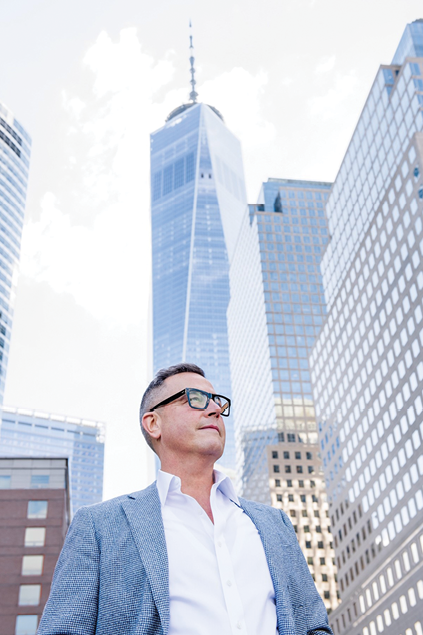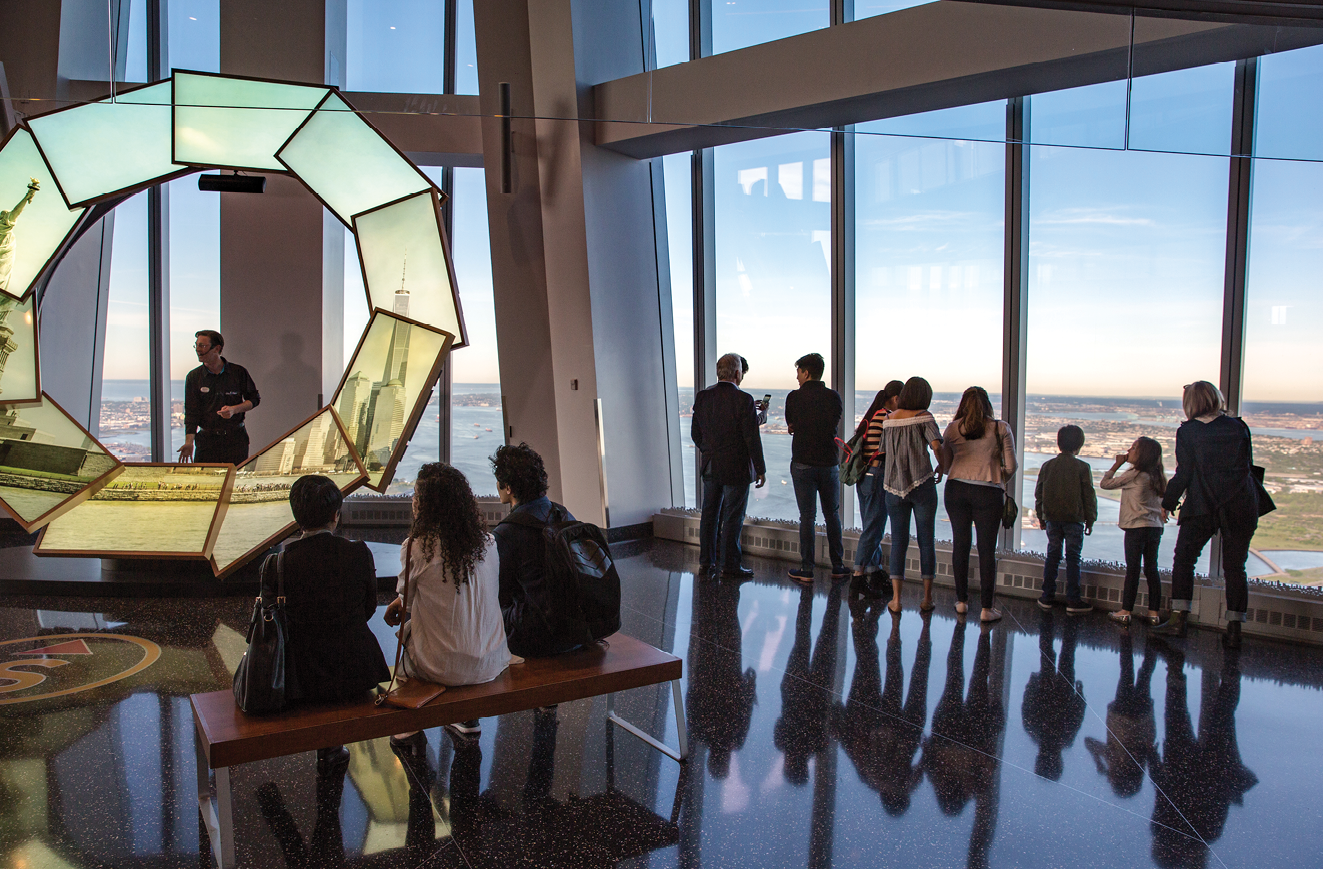- Home
- Media Kit
- Current Issue
- Past Issues
- Ad Specs-Submission
- Ad Print Settings
- Reprints (PDF)
- Photo Specifications (PDF)
- Contact Us

![]()
ONLINE


Keith Douglas in front of One World Trade Center
The Guest Experience
Editors’ Note
Keith Douglas became the Managing Director of One World Observatory in 2017. Before joining One World Observatory, Douglas was the President and Managing Director at KD&CO after having served for 10 years as the Managing Director of Rockefeller Center and Top of the Rock Observation Deck for Tishman Speyer. He also spent over a decade as a senior executive responsible for overseeing sales, marketing and general managerial roles for several leading hotel franchises including W Hotels, Omni Hotels and Doubletree. Douglas is a graduate of Johnson and Wales University, where he received his B.S. in hospitality management.
Organization Briefs
One World Observatory (oneworldobservatory.com), located at the top of One World Trade Center, is the tallest building in the Western Hemisphere and offers unparalleled panoramic views of New York and three floors of immersive, interactive experiences.
Legends (legends.net) considers its intellectual property to be its people and their expertise. Collectively, its leadership team has over 300 years of experience in sales and sponsorship, analytics and valuation, hospitality and operations. Legends’ divisions include Global Planning, Global Sales, Hospitality, Global Attractions, Global Merchandise, Legends International, and Technology and Innovation.

ONE Dine restaurant at One World Observatory
Will you highlight the history of Legends and how Legends has evolved?
At Legends, we consider ourselves a holistic agency. We provide solutions to our clients and our partners in the areas of global planning, global sales and hospitality. Legends’ advantage is providing 360-degree solutions that focus in those three areas, but it covers a broad range under those pillars that include capital and fundraising and global sales, naming rights, sponsorship, tourism and special event sales, as well as premium ticket sales.
On the hospitality side, we focus on marketing and content, operations, and food and beverage for attractions. We also have technology solutions and merchandising opportunities all under the hospitality umbrella.
On the global planning side, it is about the analytics in the market. We have an entire division that is dedicated to doing market research and analysis for projects as they’re being ideated. We do project development, project management, data analytics and also sponsorship valuation. Those comprise the holistic approach of that 360-degree advantage for Legends.
When it comes to our history, the Legends brand was created many years ago when the New York Yankees and the Dallas Cowboys were thinking about and creating their new stadiums. Those teams knew that they wanted to do hospitality in a very different way based on the demographics of their fans. They talked to all the big players and the interesting thing is that they clearly wanted to offer something extraordinarily different. The Yankees and the Cowboys believed that they should hire, and they did, some of the best and brightest in the hospitality industry and the food and beverage world. Those individuals worked with the architects and the designers in the design of the stadiums with the idea that those hospitality solutions would be delivered in a very different way.
That was the background behind Legends’ creation. We’ve grown into a 360-degree platform based on the successes at the Yankees and Cowboys stadiums.
Is brand awareness a focus for Legends or is it more about the branding of the venues?
While Legends provides solutions for its clients, it is really about the partner as opposed to Legends. We consider ourselves a white label brand. One World Observatory is a great example because we are in the World Trade Center and One World Observatory is run by Legends. However, people come here because it is One World Observatory. It is the same situation with the New York Yankees; while we run the hospitality concessions, people are clearly more interested in the Yankees brand even though Legends is producing a quality F&B product for them. The same concept applies at The Star in Dallas, or State Farm Arena in Atlanta.
At any of the locations where we’re operating, the location and the iconography of the stadium or the building is really the focus, and the role of Legends is to support the delivery of a great guest experience.

The observation deck at One World Observatory
Will you provide an overview of One World Observatory and what have been the keys to its continued growth?
One World Observatory is one of the largest observation decks in the world with 125,000 square feet over five different levels, including the entry location on the ground level. The combination of having not only the observatory, but also a truly robust restaurant, illy Caffè, and a special event program, is very important in bringing visitors here. The delivery of a great guest experience is the other thing that is a point of differentiation for us. We welcome visitors from around the world and 50 percent of our visitors are international. We have a clear focus on making those guests feel welcome and comfortable, regardless of where they’re visiting from around the world. This is one of the reasons our guest numbers continue to grow.
How do you define One World Observatory’s purpose?
The Observatory offers a way for One World Trade Center to be accessible to the general public in a way that most commercial buildings are not. It also has the luxury of being on the top three floors of the building itself and offers an amazing 360-degree experience. One World Observatory allows the general public and visitors to New York to experience the World Trade Center and the downtown area in a way that otherwise wouldn’t be available which is important since the World Trade Center has an emotional connectivity to people around the world for a variety of different reasons.
How critical has it been to continue to innovate and create new programming in order to keep One World Observatory current and relevant?
We are constantly innovating and thinking about the next thing. Guests are interested and focused on the experiential components. We look at all the touch points for the consumer when they’re with us, from the arrival on the entry level through to the Global Welcome Center. We look at the content in all the communications, whether it’s related to the history of downtown New York, telling the story of the World Trade Center Campus and the evolution of what’s happening here downtown or how the World Trade Center is interwoven into the fabric of downtown.
We also talk about the architecture and the significance of the construction of the building. We’re always trying to provide the next level for the guests to enjoy and also to ensure the consumers take a little something away. Our visitors want to know about the history of the neighborhood, they want to know about the campus, where the building is located, and they really want to know about some of the specifics, whether it be the architecture or the design of the building itself. We try to satisfy all of those points in the visitor experience here as we continue to evolve.
Running an observatory is a very visual experience and I truly think it’s about all the senses, so we have created a very subtle, signature scent for One World Observatory that the guests will experience. When a guest visits the Observatory, it is about the sight, about the sound with this wonderful background chatter of people talking in different languages while you’re here, and about the food which provides the taste component.
How important is it for you to make sure that you are spending time at the Observatory interacting with guests?
My number one priority, regardless of what’s happening, is always the associates and our team at One World Observatory, because they truly are the face of our operation here. That connectivity with our associates is so important. The second priority for me is with our partners, our customers and the guests that are coming through. When you have 14,000 visitors to welcome on a busy day, you can’t personally welcome each and every one of them, but I do make an effort to be in the operation at least once a day for a walkthrough to say hello and see how things are going for both our guests and our associates.![]()